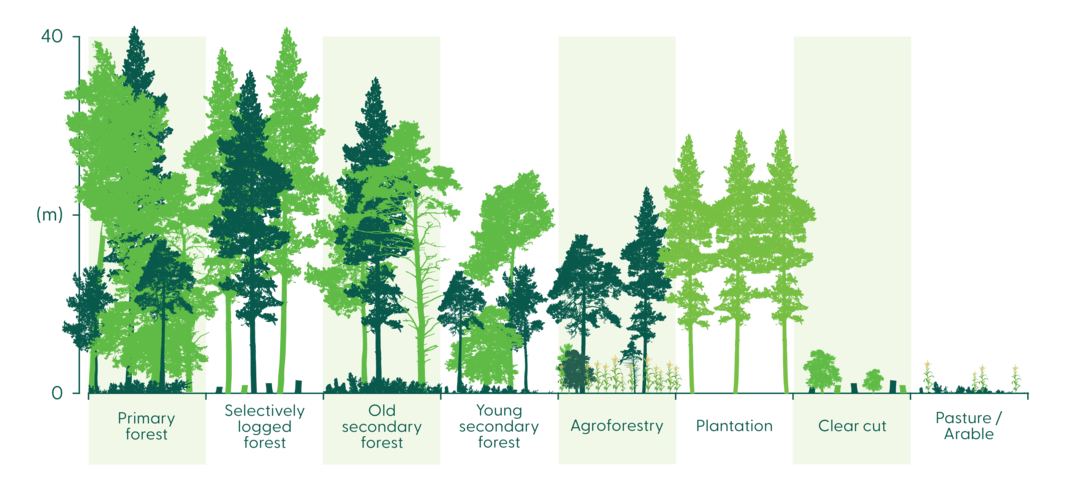As a producer of high-quality organic luxury business cards, we are committed to sourcing our paper from FSC-certified forests, ensuring that our materials are sustainably managed and environmentally friendly. It’s important to understand the differences between natural and planted forest systems to appreciate the efforts behind sustainable paper production.
Forest management is different for natural and planted forest systems.
Natural forests are ecosystems where trees and plants grow and regenerate on their own, without human intervention. These forests are typically rich in biodiversity, featuring a wide variety of tree species, plants, and wildlife. The trees in natural forests are of varying ages, creating a complex and balanced ecosystem.
Forest management in these natural ecosystems is generally low-density. The focus is on preserving the existing flora and fauna, ensuring that the forest remains a thriving, biodiverse habitat. Practices are designed to maintain the natural regeneration processes and support the health of the entire ecosystem.
Image by FSC / Jjumba Martin
Planted Forests, often referred to as plantations, are deliberately established by humans for the purpose of producing specific forest products or materials. These systems typically consist of trees that are all the same age, and there is usually less variety in terms of tree and plant species. Some plantations focus on a single species, known as monocropping.
As the pioneer of forest certification, the Forest Stewardship Council (FSC) sets the standard for responsible forest stewardship: FSC Standards | Forest Stewardship Council Image by FSC / Bablu Singh
Management of planted forest systems is usually intensive, aiming to maximize yield and efficiency. High levels of intervention are required to maintain and enhance productivity in these environments where biodiversity is relatively low. However, not all plantations lack biodiversity. Many sustainably managed plantations incorporate areas dedicated to protecting or restoring biodiversity, ensuring that the environmental impact is minimized.
By sourcing our paper stocks from FSC-certified forests, whether natural or planted, we ensure that the paper used in our business cards comes from responsibly managed sources. This commitment helps preserve biodiversity, supports sustainable forest management practices, and contributes to the overall health of our planet.
Read more: Types of Eco-Friendly Business Cards
Photo by FSC / Jonathan Perugia
Balancing Goals
Effective forest management mainly focuses on balancing productivity with ecological health. These goals guide interventions and help manage the forest sustainably. For example, increasing timber yield might reduce biodiversity, so areas are often set aside for conservation to maintain a healthy ecosystem.
Conservation Goals
Increasing the yield of a specific tree species may compromise biodiversity. To mitigate this, some areas are designated for conservation, thus reducing the area focused on yield and ensuring all species in the forest thrive. This approach aims to adapts to the unpredictability of climate changes, which can cause certain species to flourish or disappear unexpectedly. Ecological forest management attempts to protect the species balance and maintain the balance of the forest’s gene pool.
Forest management conserving biodiversity seen on the left. Intensively managed (often monocrop) operations seen on the right. Figure by “Plantation Forests and Biodiversity: Oxymoron or Opportunity?”
Economic Goals
Economic-focused management ensures a steady supply of forest products while optimizing financial returns. In natural forests, where conservation is also a priority, managers engage in extensive environmental activities to maintain the forest’s health and resilience. In plantation systems focused on economic gain, practices may include the use of fertilizers and pesticides to ensure high yields. But some plantations will also maintain natural areas to protect biodiversity, creating buffer zones along streams or designating patches for natural vegetation restoration.
Image by FSC / Mayank Bhavesh Soni
Image by FSC / Jesús Antonio Moo Yam
Social Gains
Social management supports communities relying on forests for their livelihoods, including Indigenous groups and local residents. Globally, about 300 million people rely on forests for food, fuel, medicine, and livelihoods. Management practices aim to protect their rights and ensure continued forest use. Beyond local communities, forest management can benefit people through recreation, tourism, education, and conservation of culturally or spiritually significant sites (often referred to as High Conservation Values). Workers in forest-based industries are also a focus of social goals, ensuring fair treatment, fair pay, and the prohibition of child or forced labor and workplace discrimination.
Combining Goals
Forest management often blends social and economic objectives, providing:
Income for forest owners
State income through taxation
Jobs in forestry and related fields (e.g. forest guards, tourism operators, forest schools)
Income for individuals along the wood processing value chain
Forest Management involves timber production, recreation, or conservation. These practices can sometimes negatively impact the forest if not balanced correctly, but they focus on immediate needs.
Forest Stewardship is a comprehensive approach to forest management that ensures forests can meet the needs of both current and future generations. This approach emphasizes long-term health, biodiversity, and the sustainability of the forest ecosystem.
Image by FSC / Ivan Castro
Detailed plans set short- and long-term goals, actions, and responsibilities. These plans are adaptable based on outcomes and new insights.
Timber Harvesting
Producing business cards involves using pulp from timber harvesting. Forest management practices involve ‘reduced impact logging’ (RIL) which lowers the negative impacts of logging, i.e. to harvest trees in a way that also protects the forest ecosystem and its value. In all regions of the world RIL means that forests know about the quality of the trees they fell, that they can predict the direction the trees will fall, that they don’t build unnecessary, or unnecessarily broad transport roads, and that they protect water courses.
Image by FSC IC / Phil Sharp
In the northern hemisphere, this could mean that skidding of logs happens only when soils are frozen, to avoid damage to the soil. In tropical regions it could mean cutting lianas from the trees to be felled and from neighboring trees years before the actual felling, to avoid those lianas of the falling trees tear other residual trees with them, which could causes harm to the forest workers and destroy more of the forest than necessary.
Fire Prevention and Management
Most forest fires may be started by people, but forest management can help avoid them. Persistent hotter and drier weather due to climate change has caused a stark increase in uncontrolled forest fires in recent years. Other human factors such as land conversion for agriculture and poor forest management are the main drivers behind this increase.
Image by FSC / Bablu Singh
Forest management practices that can prevent fires include controlling visitor activities, removing trash, and maintaining buffer zones between public roads. Thinning dry conifer stands and removing dead wood can also avoid uncontrolled fires, but this can have negative effects for certain insects and fungi.
Fire Management or Controlled Burning
Controlled burning, also known as prescribed burning, involves setting planned fires to maintain the health of a forest. These burns are planned and managed in detail to minimize risk. Reasons for controlled burns include preventing uncontrolled wildfires by burning dead leaves, fallen debris and thick undergrowth; destroying invasive plants; returning nutrients to the soil by turning vegetation, that would otherwise take years to decompose, into ash; and allowing more sunlight to reach young trees.
Reforestation or Planting
Reforestation involves replacing trees that have been removed by harvesting or logging, or through wildfires, disease, and drought. This can be done through natural regeneration, where seedlings from the surrounding forest fall and grow, or artificial regeneration, which involves planting seedlings.
Watershed Management
Forests are integral to the global water cycle and therefore vital for water security – they regulate water quantity, quality, and timing and provide protective functions against, for example, soil and coastal erosion, flooding, and avalanches. Forested watersheds provide 75 percent of our freshwater, delivering water to over half the world’s population. Managing watersheds ensures water quality and quantity are maintained for ecosystems and human use.
Image by FSC / Jesús Antonio Moo Yam
Environmental
Purify air, filter water, and act as carbon sinks.Economic
Supply wood and other products critical for economic activities.Social
Support communities relying on forests for their livelihood.
Sustainable forest management ensures these benefits continue for future generations. By balancing economic, ecological, and social goals, forest management helps maintain healthy and resilient forests, ensuring they can thrive and support biodiversity for years to come.
Image by FSC Brasil / Célio Cavalcante Filho






















